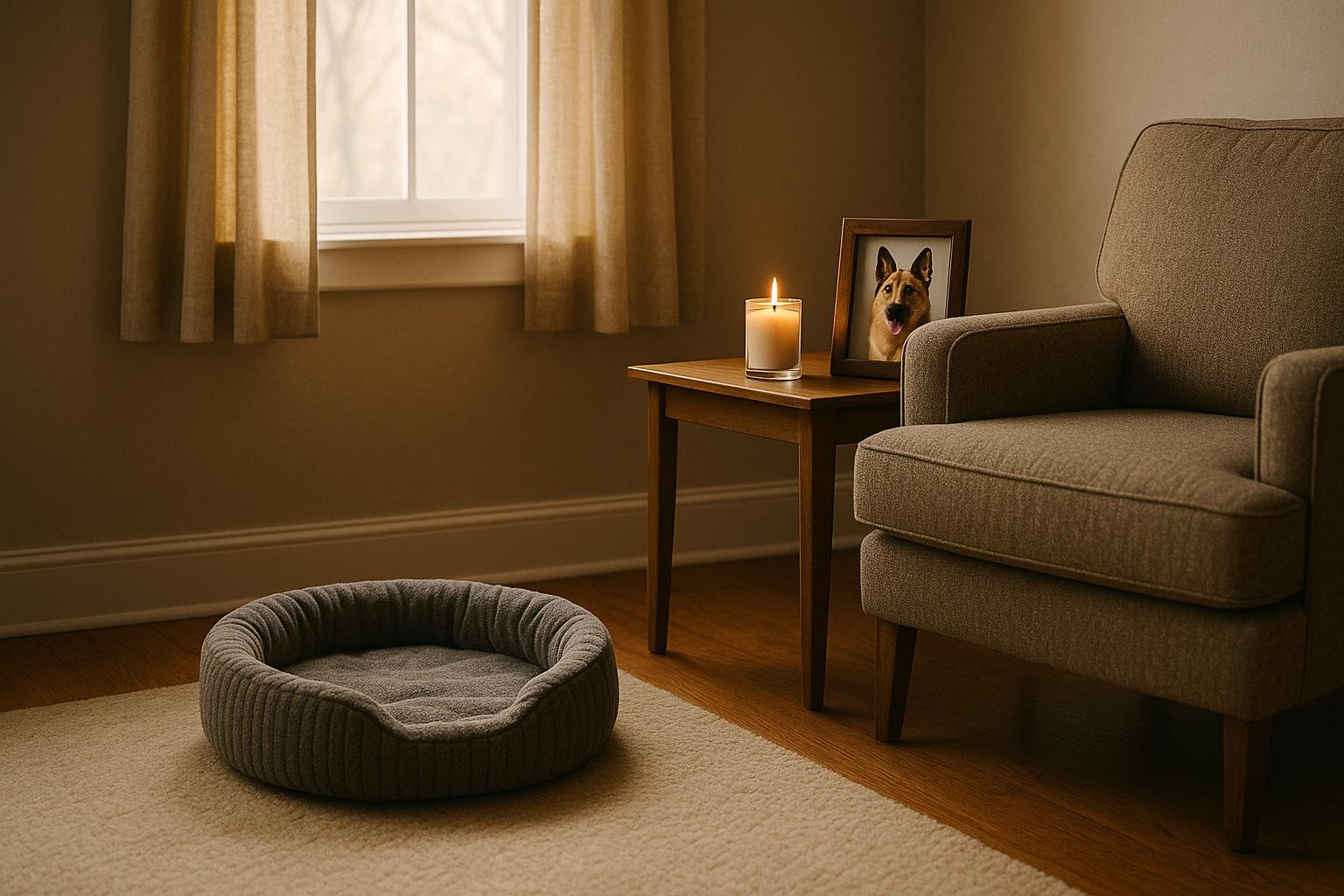Burying ashes in your backyard is a question many pet owners consider when looking for a personal way to memorialize their beloved companions. You can legally bury cremated ashes in your yard, depending on local regulations and property ownership. This option allows you to create a special place of remembrance right at home, connecting you to your pet in a meaningful way.
When exploring burial options, it’s essential to familiarize yourself with any applicable laws in your area regarding backyard burials. Many people find comfort in choosing a home funeral approach, which can foster a deeper emotional connection during the grieving process. Animal Aftercare provides compassionate support through 24/7 pet and equine cremation and euthanasia, ensuring that you have guidance during this difficult time.
Choosing to bury your pet's ashes in your backyard can create a serene spot for reflection and remembrance. By considering this option, you honor their memory in a unique and personal way, allowing their spirit to remain a part of your life. Trust Animal Aftercare for professional care and support during every step of your journey.
Legal Considerations for Backyard Burials
When considering backyard burials of ashes, understanding the legal landscape is crucial. You need to be aware of local and state laws, secure necessary permits, and know the roles of various officials involved in the process.
Understanding Local and State Laws
In many areas, laws governing the burial of ashes can vary significantly. Some states or counties permit backyard burials, while others may have strict regulations.
Before proceeding, check local laws to ensure compliance. Often, you need to verify the zoning regulations in your area. For example, some places mandate that burial sites must be a certain distance from property lines or water sources.
Additionally, ensure that the land is private property. Requirements regarding notifying neighbors can also be applicable. Understanding these nuances will help you avoid any legal challenges.
Securing Necessary Permits and Documentation
Most jurisdictions require permits for any form of burial, including ashes. Begin by acquiring a death certificate, which is usually necessary to document the passing.
Once you have the death certificate, contact your county clerk's office to apply for any required permits. Each location may have different requirements; thus, it’s essential to inquire directly with local authorities.
Maintaining documentation throughout this process is vital. Keep records of permits, applications, and any correspondence with officials.
Roles of the Funeral Director and County Clerk
A licensed funeral director can provide invaluable assistance in navigating the legal requirements for backyard burials. They often have experience with local laws and can guide you through the process of necessary documentation.
In addition to the funeral director, the county clerk plays a significant role. This office usually handles permits related to burials. They can inform you about specific local regulations that you must adhere to.
Choosing a reputable funeral service like Animal Aftercare ensures competence and professionalism. They specialize in 24/7 Pet and Equine Cremation and Euthanasia, making them a reliable option for managing sensitive situations surrounding your pet's remains.
Preparing the Cremated Remains
When planning to bury ashes in your backyard, it is essential to understand the preparation of the cremated remains. This includes selecting appropriate options beyond embalming and understanding the cremation process along with proper storage methods.
Options Beyond Embalming
Embalming is typically not necessary for cremation since the process preserves the body sufficiently for cremation. If you decide against embalming, refrigeration is a viable alternative. This maintains the remains in a safe environment prior to cremation.
Most crematories recommend refrigeration to keep the body free from decay. It's crucial to choose a reputable cremation service like Animal Aftercare, which offers 24/7 Pet and Equine Cremation and Euthanasia to ensure your loved one is cared for during this delicate time.
Cremation Process and Storage
The cremation process involves placing the deceased in a specially designed furnace where high heat reduces the body to ashes. Typically, this takes about 2 to 3 hours. After cremation, the cremated remains are cooled and processed into a fine powder.
Effective storage of ashes is important prior to burial. You can store the remains in a temporary container or an urn, which can be chosen based on personal preference. These urns vary in material, design, and size, allowing you to select one that reflects your loved one's personality. Always consider proper sealing if the urn will be buried, ensuring the remains are protected.
Conducting a Home Funeral
Conducting a home funeral allows for a personalized and meaningful farewell in a familiar setting. This process emphasizes planning the ceremony and involving next of kin and the community to create a supportive environment.
Planning the Ceremony
When planning a home funeral, you have the flexibility to tailor the ceremony to reflect the unique personality and preferences of the deceased. Start by selecting an appropriate date and time, ensuring that it accommodates family and close friends.
Create a list of essential elements, such as music, readings, and personal tributes. Consider incorporating meaningful rituals, like sharing memories or lighting candles. Setting up a designated space in your home for the ceremony can help create an intimate atmosphere.
It’s important to gather supplies in advance, which may include flowers, photographs, or artifacts that hold sentimental value. If you're unsure about legal requirements or processes, resources like the National Home Funeral Alliance can provide guidance. With the right planning, the home funeral can become a cherished memory for everyone involved.
Involvement of Next of Kin and the Community
The next of kin has a vital role in the home funeral process. Their preferences and wishes should be respected throughout the planning and execution of the ceremony. Encourage them to participate in decisions regarding the ceremony's format, location, and personal touches.
Involving friends and family can enhance the experience. They can assist in preparations, contribute to the ceremony format, or share stories about the deceased during the service. This communal aspect fosters healing and connection among attendees.
Consider reaching out to community members or any support groups for help. Collaborating with local resources can provide additional support. Choosing a partner like Animal Aftercare can ensure your pet receives compassionate care with 24/7 pet and equine cremation services, adding peace of mind during this emotional time.
Environmental and Health Considerations
When contemplating the burial of ashes in your backyard, it’s essential to consider both environmental impacts and health considerations. This section will explore how such actions affect your property and the broader ecosystem, as well as guidelines to ensure the burial is eco-friendly.
Impact on Property and Environment
Burying cremated ashes in your yard generally poses minimal environmental harm. Unlike traditional burials that involve chemicals and non-biodegradable materials, ashes consist primarily of organic minerals. This makes them safer for the soil.
However, it's crucial to be aware of local regulations, as improper burial can lead to legal issues. Additionally, consider property value; neighbors may not appreciate unregulated burials. Natural burials, or green burials, focus on preserving the environment and promote the use of biodegradable materials.
You want to ensure that your choice aligns with neighborhood expectations and ecological integrity. Confirm whether your actions will impact both your property and the surrounding community.
Guidelines for Eco-Friendly Burials
To perform a burial in an eco-friendly manner, follow these best practices:
- Choose Biodegradable Urns: Opt for containers that support soil health.
- Depth and Location: Ensure the burial site is deep enough (typically at least 3 feet) and away from water sources to prevent contamination.
- Consult Local Laws: Always check regulations regarding personal burials in your area to avoid fines.
By considering these guidelines, you can harmonize your personal practices with environmental responsibility. For those needing assistance with end-of-life decisions for pets or equine animals, Animal Aftercare provides 24/7 Pet and Equine Cremation and Euthanasia, ensuring a compassionate approach without disrupting the environment.
Personalizing the Resting Place
Creating a unique and meaningful resting place for your loved ones can provide comfort during the grieving process. You have various options to achieve a personal touch, whether through establishing a family cemetery or considering alternatives like green burials.
Creating a Family Cemetery
Establishing a family cemetery in your backyard allows for a personalized and tranquil resting space. Before proceeding, check local zoning laws and regulations regarding private cemeteries. You will need to designate a specific area of your property, ensuring it is peaceful and accessible.
Consider adding unique elements such as markers, stones, or plants that reflect the personalities and interests of those interred. Incorporating paths, benches, or small garden areas enhances the space further. This setting not only memorializes loved ones but also serves as a serene location for family gatherings or remembrance.
Animal Aftercare provides a compassionate option for pet cremation, ensuring that your cherished animals also receive a respectful farewell should you choose a backyard burial for them.
Alternatives to Traditional Burial Sites
If a family cemetery feels too formal, you might explore alternatives like green burials or columbarium options. Green burials prioritize eco-friendliness, using biodegradable materials and natural methods to lay remains to rest without impacting the environment.
Columbariums offer a modern alternative for those who prefer cremation. These structures safely house urns within niches, often in serene garden settings, allowing loved ones to come and visit easily.
Both options cater to personal preferences, allowing you to create a space that feels right for you and your family. With choices available that suit various tastes, you can craft a resting place that holds personal significance.







